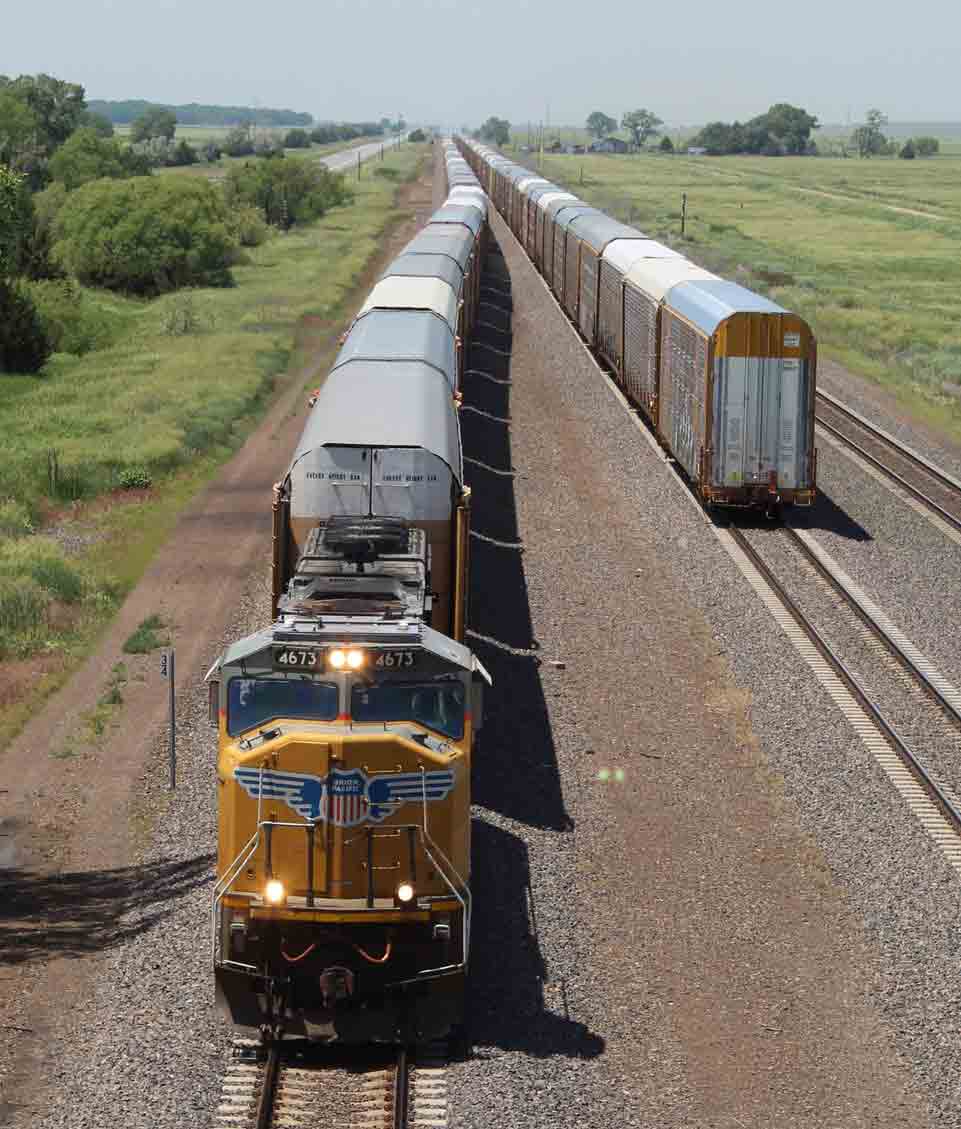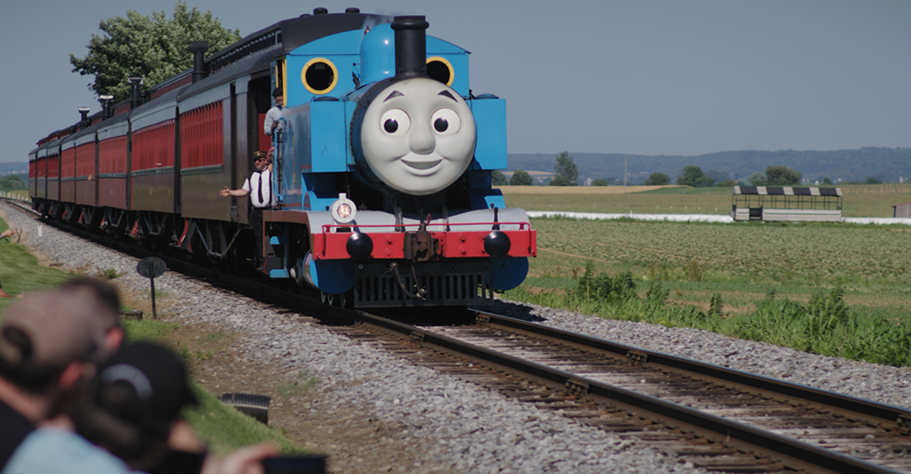CSX underwent an operational and financial transformation under CEO E. Hunter Harrison, who died in December after a little more than nine months on the job. In a year under Harrison’s Precision Scheduled Railroading model, CSX’s operating ratio went from worst to first – making it more profitable than UP.
UP’s announcement yesterday of its new Unified Plan 2020 answered the question: We will be more like CSX.
The Unified Plan will help UP hit its 60 percent operating ratio goal by 2020 and, eventually, its long-term 55 percent target, the railroad says.
Amid the changes at CSX, Fritz and other UP executives over the past year have repeatedly said they would continue to copy best practices from other railroads and industries.
And UP has been inching toward Precision Scheduled Railroading by implementing key elements of the operating philosophy. These include reducing its low-horsepower locomotive fleet by a quarter over the past three years and beginning to shift unit train traffic into the manifest network.
The Blend and Balance program at UP, which began last year with a pilot program in the Pacific Northwest, is reminiscent of the Harrison philosophy of running general purpose trains and balancing the network by running equal numbers of trains in each direction every day. The idea is to keep crews and power in balance with the added efficiency of increasing train length.
UP has moved 70 percent of finished vehicle traffic out of unit trains and into the merchandise network, executives said at the railroad’s investor day in May. UP declined to provide additional details but had said it was in the early stages of reviewing its operating plan on a corridor-by-corridor basis.
Officially adopting Precision Scheduled Railroading comes as UP has been mired in subpar operating performance for more than a year.
“We are not currently meeting customer expectations,” Fritz said in a statement. “Unified Plan 2020 is our path forward to secure our place as the industry leader in safety, service, and financial performance.”
Elements of the new operating plan include:
- Shift focus of operations from moving trains to moving cars.
- Minimize car dwell, car classification, and locomotive power requirements.
- Run general-purpose trains by blending some unit-train traffic into the manifest network.
- Balance train movements to improve crew, locomotive, and railcar utilization.
UP’s announcement means that more than half of the big six systems will follow the operational practices championed by Harrison, who developed his philosophy at Illinois Central and later brought it to Canadian National, Canadian Pacific, and CSX.
While Harrison’s operating recipes are well known, no railroad has ever implemented them as deeply and broadly as the systems Harrison has led. And UP’s decision is the first time a railroad has adopted Harrison’s principles without Harrison himself leading the charge.
But UP in February hired former CSX Chief Operating Officer Cindy Sanborn, who spent eight months helping Harrison implement Precision Scheduled Railroading in Jacksonville. She now heads UP’s Western Region.
Last year Sanborn was asked why CSX didn’t simply read Harrison’s books on Precision Scheduled Railroading and adopt his operating model while Michael Ward was chief executive. “You can read a book about brain surgery but that doesn’t make you a brain surgeon,” Sanborn replied.
Having Harrison at the helm is like learning from the professor who wrote the textbook, Sanborn said. Plus, Harrison’s experience implementing new operating plans gave him invaluable insights about making operational changes, she added.
The scheduled railroading announcement comes just a month after an operations management shuffle at UP, including the naming of Tom Lischer as executive vice president of operations. Lischer replaces Chief Operating Officer Cameron Scott, who is retiring effective Feb. 28.
Also a question mark: Can UP make significant operational changes without the disruption that accompanied the rapid operational changes Harrison made while leading CN, CP, and CSX?
UP seems intent on taking a go-slow approach. It will phase-in operational changes over the next 15 months, beginning Oct. 1 in its Chicago-Texas corridor, and develop the new operating plan in conjunction with field operating people. UP also pledges to communicate with customers well in advance of operational changes.
“We will closely monitor the impact of these changes to align our strategy with our overall goals to improve network performance and provide the reliable service you have come to expect,” Kenny Rocker, UP’s new executive vice president for marketing and sales, told customers yesterday.
This is a contrast to Harrison’s top-down methods, which were so fast-paced at CSX that the railroad’s marketing people often did not have time to communicate operational changes with customers until after the fact.
UP’s announcement is likely to only ratchet up investor pressure on Norfolk Southern, CSX’s rival in the East.
On Norfolk Southern’s second-quarter earnings call, CEO Jim Squires faced the same Wall Street analyst questions about why his railroad couldn’t move as fast as CSX to cut costs and boost profitability.
Like UP, NS reported record quarterly financial results. But its operating ratio did not keep pace with the progress at CSX.
CSX posted a record 58.6-percent operating ratio for the second quarter. NS’s operating ratio was a record, too, but at 64.6 percent it was 6 points higher than CSX’s and ranked last among the publicly traded Class I railroads.
Independent analyst Anthony B. Hatch was amazed at the timing of the UP announcement.
“One of the interesting things is this is relatively shortly after their investor conference, where they laid out plans including a $20 billion share buyback,” Hatch says. “So – one thing is – maybe investors are wising up beyond the short-term buyback focus. Or maybe it means investors remain short-term oriented and look only to operating ratio improvement. Time will tell.”
Hatch notes that UP’s second-quarter earnings were impressive, making the CSX comparisons surprising.
“In my 30 years I never thought that the Union Pacific would be taken to task for the ‘crime’ of not being the CSX,” Hatch says. “And now it’s coming to pass – the mighty UP is becoming (more like) the CSX (down to actually calling it ‘PSR’)!
“Somewhere, up there,” Hatch adds, “EHH is having a belly-laugh!”















Hatch says. “So – one thing is – maybe investors are wising up beyond the short-term buyback focus. Or maybe it means investors remain short-term oriented and look only to operating ratio improvement.”
Investors remain short term oriented and look only to operating ratio improvement?
Hell, Even Helen Keller could see that!
I interpret this as Lance Fritz tossing the Wall Street dogs a bone. Whatever version of PSR UP actually implements is probably less important to “the Street” than the fact Fritz has finally uttered those three magic words: precision – scheduled – railroading.
And I will concur with Mr. Spindler’s thoughts on the share buyback.
$20 billion share buyback — this is the key statement in the article.
That is $20B that will NOT be invested in capacity or allowing for any redundancy. It will be financed by issuing long term debt to juice short term stock price.
And UP has been pretty good about having service quality meltdowns on a regular basis. Look for them in the coming months.
The way it is written, its sounds like utilising the good parts of “precision railroading” , but has little in common with most of what HH did at CSX. That is good , learn from what others do right , avoid making the same mistakes they did.
Yard dwell no UP has been a problem in certain places for a long time, and at almost every yard sine the beginning of this year. If they can successfully tackle that problem, the should significantly reduce car hire expense, relieve congestion and get customers to route UP again.
There they go “operating ratio” . To hell with the fact UP made more money than CSX. If they implement that like Harrison did and once they get it all done to plant, locomotives, employees reduced, they will be unable to function just like the jam CN got into and CP when a large increase in business comes. They will lose traffic to trucks. Just look at CSX where they handle LESS TRAFFIC than they used to and make less gross profit. Oh, I forgot, they got a better OPR than UP. Who cares?
I suggest stop trying to manage a railroad to please Wall St. Manage the railroad for the good of the railroad. To hell with Wall St.. If you can make a buck hauling freight, then haul it.
Do you know this for a fact Stephen? Is there some kind of inside Intel you have or are you reading a crystal ball. PR pieces can be made to sound like anything. Nowhere did I read that UP would not close down any humps or yards. I’m not saying they will, but I also haven’t read where there wouldn’t be.
Next year when PTC implementation bogs down the national network most if not all of this stuff will be out the window. But for now it makes great press.
At least UP is not closing down hump yards, nor focusing on just the operating ratio, like Harrison did with all the railroads he ramrodded.
As an investor with UP, what I see they are working on is the attempt to improve fluidity in their high volume corridors such as, like the article mentions, the Chicago-Texas corridor. This corridor has long been a trouble zone for UP since taking over the Mo Pac, and made only worse by the unique problems post merger with SP with all the chemical and general merchandise traffic. In the LONG term, it would be nice to see UP work out the long standing kinks in the system and seriously improve service and I think now they might be looking at doing such a thing.
Time will tell one way or another if actions speak louder than words. If not, then someone, somewhere is not doing their job right.
Same here Troy. UP stock up today. Kind of scary.
Well as a shareholder I want them to do well but I hope what is done is not for the sake of a quick bump in share prices that caters to day traders and groups that churn stock. If UP is more profitable long term than all power to them.
Mr. Bauer, what I meant in that was that UP management sees value in hump yards, where Hunter Harrison saw little to no value in them. As far as I understand Lance Fritz and some of the thinking at UP, unless a hump yard cannot fulfill the job without being a money pit, then UP will keep all available hump yards active since where they are located is both strategic and where over 1000 cars a day come together for processing. My bad for not being more clearly definitive in that statement.
One difference is that UP is (still?) moving forward with a new hump yard at Hearne. Whether that allows Englewood and/or the Davidson humps to be closed on a possible 2 for 1 deal remains to be seen. Or maybe even the North Little Rock/Pine Bluff northbound/southbound pair instead or all together.
I’d also like to see West Colton and the super valuable land it sits on turned into an intermodal ramp serving the Inland Empire distribution centers, perhaps with a small block swap footprint for carload trains off the Palmdale Cutoff, Cajon and the Sunset. But whether all carload freight classification for SoCal, Vegas and Phoenix/Tucson O/Ds could be pushed out to Roseville, North Platte and Hearne without the WC hump operating is an open question though.